Ducks are one of the waterfowl species from the family Anatidae. They possess large bills, short necks and are relatively small compared to the other waterfowl species of the same family, like swans.
Furthermore, you can keep some of the black and white duck breeds as pets or raise them for eggs.
So, what are the different black and white duck breeds? Some of the black and white duck species are:
- Ancona—Domestic ducks known for their unique and uneven broken-colored plumage pattern.
- Muscovy Duck—Large, American native duck with feral breeding populations, particularly in Florida, Hawaii, Louisiana, etc.
- Magpie Duck—Domestic British duck breed with unusual black and white markings, like the European magpie.
In this article, you’ll get to know sixteen different breeds of black and white ducks and get familiarized with their appearance. We’ll also include their place of origin and their respective characteristics, so you better keep on reading!
16 Black and White Duck Breeds
Ancona Duck
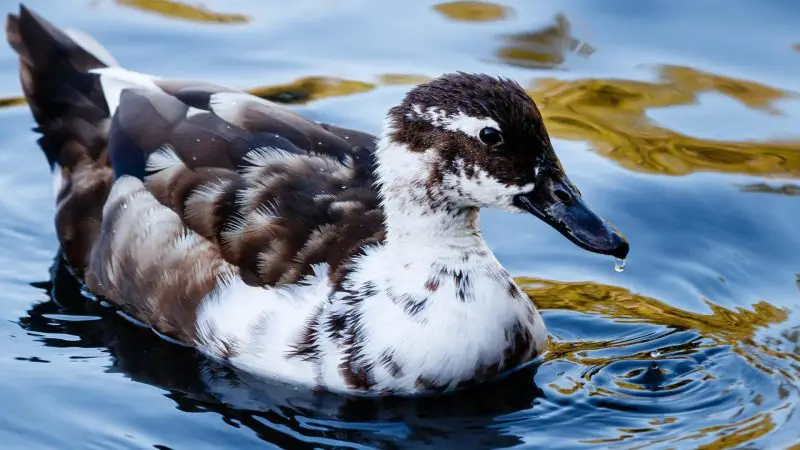
The Ancona (Anas platyrhynchos domesticus) is a domestic duck breed distinguished by a distinctive and irregular broken-colored plumage pattern. It’s not clear whether this breed originated in the United States or the United Kingdom.
The Ancona duck isn’t listed or recognized by the American Poultry Association, the Poultry Club of Great Britain, or even the L’entente Européenne d’Aviculture et de Cuniculture.
- Appearance: Ducks of this breed possess a medium-length bill and an oval and medium-sized head. Moreover, their necks arch forward slightly and have a unique broken-colored plumage pattern.
- Lifespan: 10 years
- Size: 5 pounds to 6.5 pounds in weight, medium in length
- Place of Origin: Unknown
- Characteristics: Oval, medium-sized head and neck—narrow at the top and wider at the bottom; plumage under the eyes.
Common Goldeneye Duck
The Common Goldeneye (Bucephala Clangula) is a unique wintering bird commonly found in the state of Tennessee from early November to early April. This North American breed range extends across the forested Canada regions and the Atlantic and Pacific coasts.
- Appearance: The head of the male common goldeneye duck is greenish-black with a bright white oval patch around the base of its bill. The back wings and tail are black, with a white side, breast, and belly.
Furthermore, the male’s eyes are golden-yellow. On the contrary, the female goldeneye duck has a chocolate brown head, gray body, and pale yellow eyes. When these ducks take flight, their wings make a distinct whistling sound.
- Lifespan: 18 years
- Size: 1.9 pounds in weight, 18.5 inches in length
- Place of Origin: North America
- Characteristics: Medium-sized ducks with large heads and small, narrow bills sloping smoothly down from the face—giving their heads an overall triangular form. They also possess short tails and streamlined bodies.
Bufflehead Duck
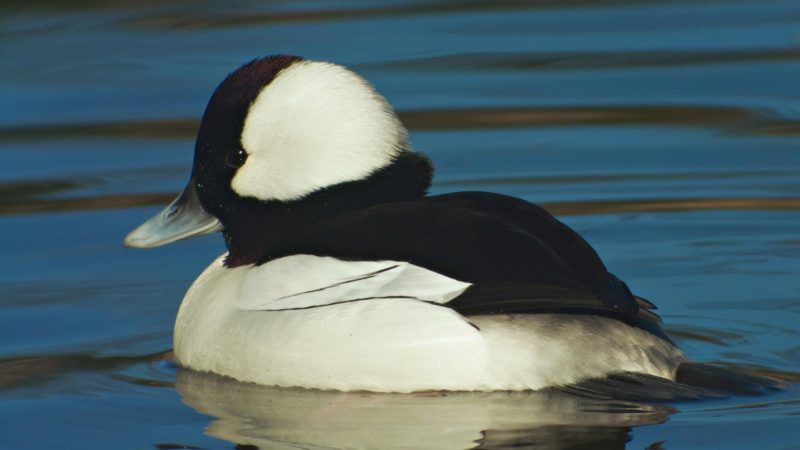
The Bufflehead (Bucephala albeola) is one of the most common and smallest ducks that typically spend winter in Tennessee. You can quickly identify them at a distance due to their large heads and the big white patch on their backs.
- Appearance: The male bufflehead duck possesses a large white patch on the back of its large iridescent purple-green head that appears black in poor light. Moreover, its back is black with a white body.
On the other hand, the female has an overall gray-brown head with a small oval white patch on its sides. When flying shortly, the white patch on the wings of the female is smaller than the male.
- Lifespan: 2.5 years
- Size: 1 pound in weight, 13.5 inches in length
- Place of Origin: North America
- Characteristics: The adult male Bufflehead has a dark head, white body, black back, with a large white patch wrapped around the back of its head. Overall, first-year males and females are gray-brown with an oval, white patch on their cheeks.
Muscovy Duck
Muscovy ducks (Cairina moschata) are unique waterfowl species with their bright red caruncles near their eyes and above their bills. These ducks don’t swim much as their oil glands are underdeveloped than most ducks.
The Muscovy breeds are genetically distinct from other ducks as most domestic ducks descend from the mallard, but not the Muscovy. These ducks come from the Nettapus species, and unlike most ducks that quack, this duck type hisses.
- Appearance: Muscovy ducks’ faces are fleshy red and bumpy near their beak and eyes. They’re heavy-bodied and possess long necks that make them look similar to small geese.
Furthermore, they have a fairly long nib that inclines smoothly up to their forehead. The males are larger than females, and the domesticated ones are usually larger than those in the wild.
- Lifespan: 20 years
- Size: 15 pounds in weight (full-grown), 30 inches in length
- Place of Origin: South America
- Characteristics: Muscovies have several colors, but most are white or pied—half black and half white. Others are buff, chocolate, lilac, brown and blue.
Greater Scaup
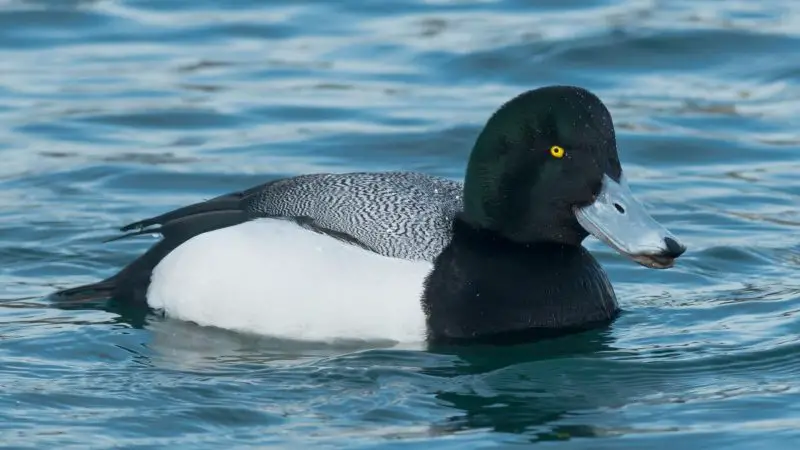
Greater scaup (Aythya marila) is a diving duck from the Anatidae family of Anseriformes order with the scientific name Aythya marila. The females are brown, while the males are brown and gray with a blackish head.
The greater scaups’ back and sides are lighter with bigger black nails on the tip of their bill, which isn’t easy to see. During winter, these ducks can be seen around coastal regions’ lakes.
- Appearance: This duck breed has bright yellow eyes, a grayish-blue beak with a black tip, and a rounded head. The male has white sides, a gray back, a black chest, and a tail.
Its head and neck appear black but are actually greenish-black in a good light. On the other hand, females are brown with a white patch next to the nib and darker brown heads.
- Lifespan: 18 years
- Size: 1.6 pounds to 3 pounds in weight, 15 inches to 22 inches in length
- Place of Origin: North America
- Characteristics: These diving ducks are medium-sized with yellow eyes and an even rounded head. They also have a dark head and chest with gray back and white sides. The greenish iridescence on their heads is only visible with great lighting.
Magpie Duck
Magpie ducks (Anas platyrhynchos domesticus) are typically calm and docile breeds. They’re not startled easily as their Indian Runner duck predecessors but are still more high-strung and inclined to panic than Rouen, Pekin, and Khaki Campbell ducks.
Like most domesticated duck breeds, Magpies can’t fly. They’re active foragers that graze and hunt for a part of their feed from insects, seeds, grass, and aquatic life.
Furthermore, they also consume snails, slugs, and insects.
- Appearance: The Magpie duck plumage is primarily white with two large black spots on their backs and the top of their heads. The black cap typically starts to be flecked with white based on ducks’ age.
- Lifespan: 9 to 12 years
- Size: 4 pounds to 5 pounds in weight
- Place of Origin: United Kingdom
- Characteristics: The Magpie is a long-bodied bird with a long yellow or orange bill and broad head.
Moreover, the ducklings are yellow, with black caps and dark coloration on the sides of the body and wings. This breed can be friendly and become easy to manage if held regularly well from a young age.
Hooded Merganser
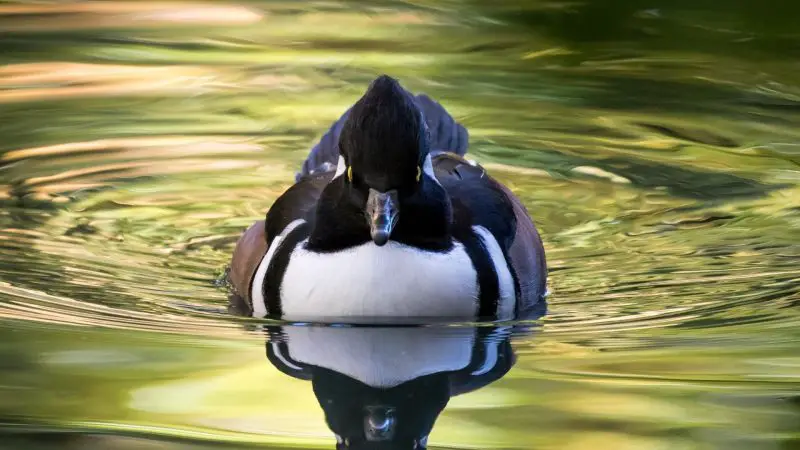
Hooded Mergansers (Lophodytes cucullatus)are found commonly on small rivers and ponds where they dive for fish and use their thin, serrated beaks to seize their food. These ducks typically nest in tree cavities.
Their diet includes crayfish, small fish, and other crustaceans. Furthermore, they also eat mollusks, tadpoles, and a little portion of plant material like seeds and leaves.
- Appearance: Hooded Mergansers are small ducks from the family Anatidae that have delicate bills and a collapsible fan-like crest. This makes their heads appear like an oversized oblong.
Adult males are patterned with dark, iridescent-green heads and glowing white bodies. On top of that, their bills are red, and their backs are black. Meanwhile, immature hooded mergansers and females are gray-bodied with rusty-cinnamon heads and white chests.
- Lifespan: 13 years
- Size: 16.8 inches to 20 inches in length, 1.4 pounds in weight
- Place of Origin: North America
- Characteristics: These ducks possess collapsible fan-like crests that can either be closed or spread. Furthermore, they swim low in the water with their legs far back on their bodies.
They do that to help them in diving but make them inept on land. They usually take flight by sprinting across the water and soaring with fast wing beats without gliding until they’re about to land.
Wood Duck
Wood ducks (Aix sponsa) live in the Southeast and the Pacific coast. These duck breeds are usually 19 inches in length and 11/2 pounds.
Their highest population can be found on the Atlantic and Gulf Coasts. They have green and purple heads and crests, traced with white lines.
Furthermore, they have white throat and neck and chestnut brown breasts with some presence of white flecks. Part of the diet of these ducks are fruits, seeds, arthropods, and other insects.
- Appearance: Wood Ducks possess a unique shape among duck species with their boxy, crested head, long, broad tail, and thin neck. These ducks are also colorful and own long toes and claws, enabling them to perch in trees.
- Lifespan: 15 years
- Size: 16 inches to 21 inches long, 1.5 pounds
- Place of Origin: Southeast and the Pacific coast
- Characteristics: The wood ducks are unique species with boxy, crested heads, long, broad tails, and thin necks. Overall, the silhouette of these ducks shows a skinny neck, long body, short wings, thick tail, and a long body.
Pomeranian Duck

The Pomeranian duck (Anas platyrhynchos domesticus) is a medium-sized duck with a traditional black or blue body and white breast. The male weighs 6.5 pounds, while the female typically weighs 5.5 pounds.
Moreover, these ducks are omnivorous and usually feed on snails, slugs, insects, rice bran, crustaceans, and more.
- Appearance: The bodies of these ducks are relatively long with a very upright bearing. Their respective abdomen is deep and broad, enabling them to bring themselves more horizontally to the ground.
They have dark beaks with dark brown eyes when seen from above. In addition, they have colored areas on their shoulders and backs, resembling a heart.
- Lifespan: 12 years
- Size: 5.5 pounds for females, 6.5 pounds for males
- Place of Origin: Germany
- Characteristics: These ducks are highly trainable, aggressive, and docile. They typically have blue or black bodies, white breasts, dark brown eyes, and black feet and beaks.
Tufted Duck
The tufted duck (Aythya fuligula)is a medium-sized duck with a small crest and yellow eyes. Its head, neck, breast, and back are black with white sides.
They normally feed on waterweed, water insects, and plant seeds. They can be found in North America to the northeast of Europe and Iceland, reaching Alaska and the Pacific Coast.
- Appearance: These ducks are medium-sized and much smaller than a mallard. They’re typically black with white color on the sides and possess prominent head tufts.
- Lifespan: 14 years, but the average age is 4
- Size: 1.9 pounds in weight, 17 inches in length
- Place of Origin: Northern Eurasia
- Characteristics: The tufted duck has a distinctive black tuft found on the back of its head. The tuft is more prominent in males and is less noticeable in females since their tuft is brown.
Crested Duck
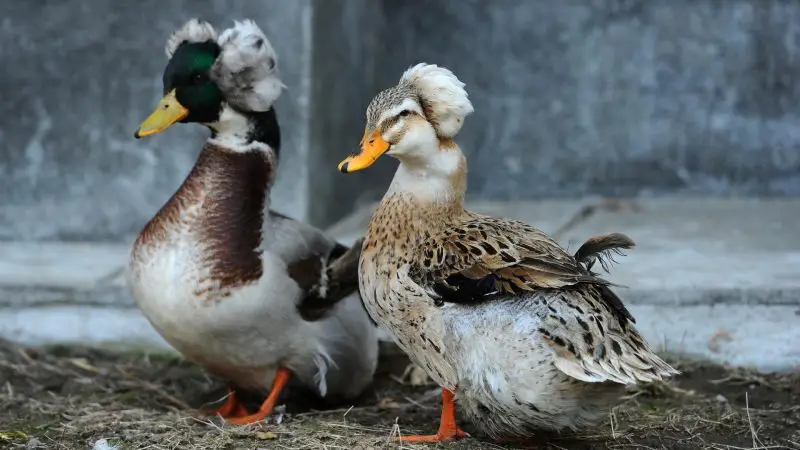
The Crested Ducks (Lophonetta specularioides)have large, heavy bodies, making them poor fliers. Nevertheless, they have strong wings and hollow bones common to other duck types.
These ducks have no teeth but have jagged edges on their bills, helping them filter food from the water.
Moreover, they’re also called dabbling ducks as they rarely dive into the water and only swim and feed on the water surface.
However, when food isn’t obtainable at the water surface, the crested ducks dive into the water to hunt crustaceans, mollusks, and insect larvae.
- Appearance: The appearance of the adult male is all black besides the gold-yellow eyes, white flanks, and blue-grey bill. Meanwhile, the mature female is brown with lighter flanks, making them mistaken for other diving ducks.
- Lifespan: 4 years
- Size: 6 pounds in weight (matured), 19.6-23.6 inches in height
- Place of Origin: South America
- Characteristics: The crest of the Crested duck is large and centered on top of its skull. It has a long and slightly arched neck with a medium-length body and a full breast.
Smew
The smew (Mergellus albellus)is a small, compact duck species with a flimsy bill. The females are grey with white cheeks and a reddish-brown head.
Meanwhile, males are white with black backs and masks. They usually live in slow-flowing rivers and fish-rich lakes.
Furthermore, they use their bills’ jagged edges and hooked tips to catch fish. They also generally feed on pupae and larvae found under rocks, plant material, seeds, small fish, crabs, and snails.
- Appearance: The drake smew has a panda appearance with unique black-and-white imagery in flight. The immature ducks are grey in color with chestnut crowns and foreheads and can sometimes be confused at a distance with the ruddy duck.
- Lifespan: 10 years
- Size: 4 pounds in weight, 15–17 inches long
- Place of Origin: Northern Germany
- Characteristics: The smew is a small, thick, diving duck with a flimsy bill. The male is white with a black back and a black mask, while the female is grey with a white cheek and reddish-brown head.
Long-Tailed Duck

The long-tailed duck (Clangula hyemalis) is a little sea duck with steep foreheads and small round heads. Males are usually white with some brownish-black markings during winter.
Their flight is erratic, with unusual deep and shallow upbeats. Moreover, their sea diet is mainly mollusks, including clams, mussels, and periwinkles. They also feed on crustaceans, such as amphipods, isopods, and a few small fish.
- Appearance: The males are stunning with their black with a white face patch. Furthermore, the males have long slender tail feathers, while the females have none.
- Lifespan: 15.3 years
- Size: 2 pounds in weight, 15 to 22 inches in length
- Place of Origin: Arctic
- Characteristics: Long-tailed duck is a slender sea duck with a small bill and round head. In winter, these ducks turn white with a big dark patch on the neck.
The bodies and breasts of the males are dark, with white plumes wrapping their back, and the bill is mainly black with a pink band. Meanwhile, young males and females have smudgy brown bodies and white faces with brown crowns, cheek patches, and dark bills.
King Eider
King eiders (Somateria spectabilis) are large sea ducks, popularly known to cross-breed with the Common Eiders. They’re called ‘king’ due to the orange, crown-like knob found above their bills.
When it comes to diet, they feed on a variety of crustaceans, shellfish, echinoderms, and algae.
They capture their food with their bills and often consume it even when they’re still underwater. On land, they typically feed on insects and plant matter.
- Appearance: Adult males have pale heads and necks while most of their bodies are black. Their respective crowns are blue-gray, and their faces are greenish. Furthermore, they have white backs, underwings, flanks, and upper wings. On the other hand, adult females are rusty brown with intricate black patterns.
- Lifespan: 15 to 20 years
- Size: 2.2 pounds in weight, 20 to 28 inches in length
- Place of Origin: Arctic
- Characteristics: Adult king eider males are mainly black in color except for their pale necks and heads. Their crown is blue-gray with a greenish face.
Common Merganser
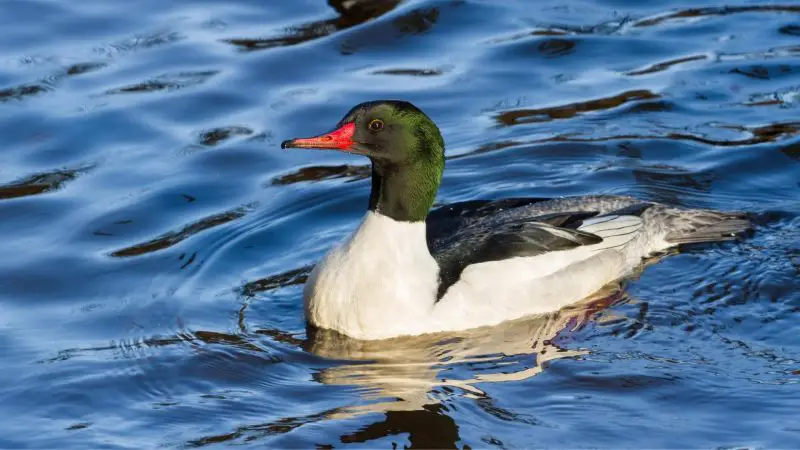
Common Mergansers (Mergus merganser) are fish-eating ducks that gracefully float down on small rivers or shallow shorelines. These large ducks nest in hollow trees and flocks on larger bodies of water every winter.
These ducks primarily eat fish, but they also feast on mollusks, crustaceans, and worms. On top of that, they also eat frogs, birds, small mammals, and plants.
- Appearance: Adult Common Mergansers males are patterned with dark, iridescent-green heads and shimmering white bodies. They also have red bills and black backs. The females and immatures of this species are gray-bodied with rusty-cinnamon heads and white chests.
- Lifespan: 13 years
- Size: 2 pounds in weight, 23 inches long
- Place of Origin: North America
- Characteristics: These large ducks have thin, pointed wings with straight and narrow bills. They’re also among the fastest flying ducks, with a clocking speed of 81 miles per hour.
Barrow’s Goldeneye
The Barrow’s Goldeneye males are some of the most striking ducks due to their crisp black-and-white bodies, purplish heads, and long white crescent shape on their faces.
Females, on the other hand, are gray in color with brown heads and orange-yellow bills. Goldeneyes start to breed either in April or May.
They usually nest in the cavities of trees and other hollows, abandoned by woodpeckers. They also nest on boxes and chimneys made from wood chips.
These ducks primarily eat aquatic invertebrates, but their diet varies throughout the year.
During the breeding season, they consume heavily on insect larvae of dragonfly, mayfly, damselfly, caddisfly, etc. They also eat isopods, crayfish, and amphipods.
- Appearance: The Barrow’s Goldeneye males have crisp black-and-white bodies, purplish heads, and an elongated white crescent on the face. Meanwhile, females have a cool gray color with brown heads and an orange-yellow bill.
- Lifespan: 18 years
- Size: 2 to 3 pounds
- Place of Origin: North America
- Characteristics: These diving ducks feed in flocks and dive simultaneously. They tend to forage in shallow waters and are fast fliers. Their wings make a distinct whistling sound during flight.
Summary
With over 100 duck breeds existing in the world, it can be challenging to decide which types are best to keep as pets or raise for their eggs. So, if you want to raise a duck, take a look at the list of several breeds above to help you determine which ones are the best for you.
